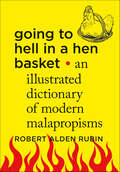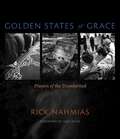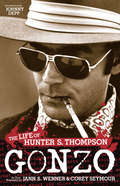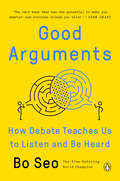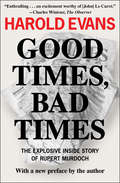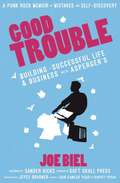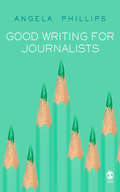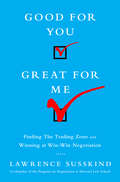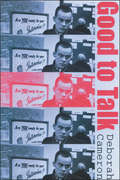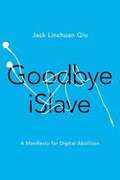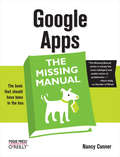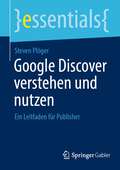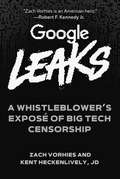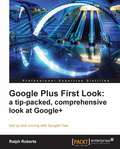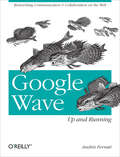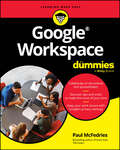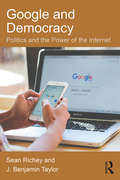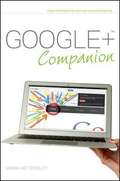- Table View
- List View
Going to Hell in a Hen Basket: An Illustrated Dictionary of Modern Malapropisms
by Robert Alden Rubin“A pain staking but hilarious journey amidst the strings and arrows of language misfortune . . . The result is the perfect gift book for word nerds.” —BrevityMalapropism—A word or phrase that has been mistaken for another, usually because of its sound rather than its meaning.Everyone has made the mistake of using a word or phrase that they think sounds correct, but in fact is not. Malapropisms make some sense. They have a semantic logic to them, even if that logic makes perfect nonsense. In Going to Hell in a Hen Basket, author Robert Alden Rubin delights in the creative misuse of words and celebrates the verbal and textual flubs that ignore the conventions of proper English.Culled from blogs, the deepest corners of the internet, as well as some of the most esteemed publications, here is a collection of classic malapropisms paired with hilarious illustrations.Examples include:adieu, without further—Conflation of bidding adieu (saying goodbye) with ado (complicated doings, ceremony) to mean “without saying anything more.”feeble position—An unborn child in a fetal position seems weak and helpless, which explains the confusion here. The two words also share some sexist cultural and literary associations. Feeble (weak) originates from a Latin word for something to be wept over; fetal (relating to a fetus) originates from the same preliterate Indo-European word that gives us female.Perfect for bookworms and wordsmiths, the point here isn’t to shame the malapropagandists, but to delight in the twists and turns writers put our language through and to amuse and inform those of us who care about words.
Golden States of Grace: Prayers of the Disinherited
by Rick NahmiasTaking California as a window into the diversity of religion in America, Golden States of Grace documents marginalized communities at prayer in their own faith traditions. The collection is thoroughly interfaith, introducing us to the nation's only halfway house for addicts self-identified as Jewish, a transsexual gospel choir, a Buddhist community in San Quentin, a Mormon congregation organized by the deaf for the deaf, Latina sex workers worshipping the female folk deity Santísima Muerte, and more. Depictions of conventional middle-class religion are widely visible in the media, but the American public rarely sees the sacred worlds of society's marginalized: the outcasts, the fallen, those that have been labeled "other" - ironically, those whom religion aims to serve. The poignant stories Nahmias has gathered here cross numerous boundaries and ask difficult questions few outsiders have been willing to pose.
Gonzo: The Life of Hunter S. Thompson
by Corey Seymour Johnny Depp Jann S. WennerFew American lives are stranger, more action-packed, or wilder than that of Hunter S. Thompson. Born a rebel in Louisville , Kentucky, Thompson spent a lifetime channeling his energy and insight into such landmark works as Fear and Loathing in Las Vegas - and his singular and provocative style challenged and revolutionized writing. Now, for the first time ever, Jann Wenner and Corey Seymour have interviewed the Good Doctor's friends, family, acquaintances and colleagues and woven their memories into a brilliant oral biography. From Hell's Angels leader Sonny Barger to Ralph Steadman to Jack Nicholson to Jimmy Buffett to Pat Buchanan to Marilyn Manson and Thompson's two wives, son, and longtime personal assistant, more than 100 members of Thompson's inner circle bring into vivid focus the life of a man who was even more complicated, tormented, and talented than any previous portrait has shown. It's all here in its uncensored glory: the creative frenzies, the love affairs, the drugs and booze and guns and explosives and, ultimately, the tragic suicide. As Thompson was fond of saying, "Buy the ticket, take the ride."
Good Arguments: How Debate Teaches Us to Listen and Be Heard
by Bo Seo&“The rare book that has the potential to make you smarter—and everyone around you wiser.&” —Adam Grant Two-time world champion debater and former coach of the Harvard debate team, Bo Seo tells the inspiring story of his life in competitive debating and reveals the timeless secrets of effective communication and persuasionWhen Bo Seo was 8 years old, he and his family migrated from Korea to Australia. At the time, he did not speak English, and, unsurprisingly, struggled at school. But, then, in fifth grade, something happened to change his life: he discovered competitive debate. Immediately, he was hooked. It turned out, perhaps counterintuitively, that debating was the perfect activity for someone shy and unsure of himself. It became a way for Bo not only to find his voice, but to excel socially and academically. And he&’s not the only one. Far from it: presidents, Supreme Court justices, and CEOs are all disproportionally debaters. This is hardly a coincidence. By tracing his own journey from immigrant kid to world champion, Seo shows how the skills of debating—information gathering, truth finding, lucidity, organization, and persuasion—are often the cornerstone of successful careers and happy lives.Drawing insights from its strategies, structure, and history, Seo teaches readers the skills of competitive debate, and in doing so shows how they can improve their communication with friends, family, and colleagues alike. He takes readers on a thrilling intellectual adventure into the eccentric and brilliant subculture of competitive debate, touching on everything from the radical politics of Malcom X to Artificial Intelligence. Seo proves beyond a shadow of a doubt that, far from being a source of conflict, good-faith debate can enrich our daily lives. Indeed, these good arguments are essential to a flourishing democracy, and are more important than ever at time when bad faith is all around, and our democracy seems so imperiled.
Good Arguments: What the art of debating can teach us about listening better and disagreeing well
by Bo SeoAt a time when every disagreement turns toxic, world champion debater Bo Seo reveals the timeless secrets of effective communication and persuasion.When Bo Seo was 8 years old, he and his family migrated from Korea to Australia. At the time, he did not speak English, and, unsurprisingly, struggled at school. But, then, in year five, something happened to change his life: he was introduced to debating.Immediately, he was hooked. It turned out, perhaps counterintuitively, that debating was the perfect activity for someone shy and unsure of himself. It became a way for Bo not only to find his voice, but to excel socially and academically. He went on to win world titles with the Australian schools and Harvard University teams.But debating isn&’t just about winning or losing an argument: it&’s about information gathering, truth finding, lucidity, organization, and persuasion. It&’s about being able to engage with views you disagree with, without the argument turning toxic.Good Arguments shares insights from the strategy, structure and history of debating to teach readers how they might better communicate with friends, family and colleagues. Touching on everything from the radical politics of Malcom X to Artificial Intelligence, Seo proves beyond a shadow of a doubt that, far from being a source of conflict, good-faith debate can enrich our daily lives. Indeed, these good arguments are more important than ever at time when bad faith is all around, and our democracy seems so imperiled.&‘From two-time world champion debater Bo Seo, a thoughtful, instructive and eloquent meditation on the art of debate and why its central pillars - fact-finding, reason, persuasion and listening to opponents - are so valuable in today&’s alarming ecosystem of misinformation and extreme emotion. When Bo Seo&’s family immigrated from South Korea to Australia, he was a shy, conflict-averse eight year old who worried about being an outsider, and in &“Good Arguments,&” he recounts how debate not only helped him to cross language lines, but also gave him confidence and a voice of his own.&’ Michiko Kakutani, former chief book critic for The New York Times.
Good Charts: The HBR Guide to Making Smarter, More Persuasive Data Visualizations
by Scott BerinatoDataviz-the new language of businessA good visualization can communicate the nature and potential impact of information and ideas more powerfully than any other form of communication.For a long time "dataviz" was left to specialists-data scientists and professional designers. No longer. A new generation of tools and massive amounts of available data make it easy for anyone to create visualizations that communicate ideas far more effectively than generic spreadsheet charts ever could.What's more, building good charts is quickly becoming a need-to-have skill for managers. If you're not doing it, other managers are, and they're getting noticed for it and getting credit for contributing to your company's success.In Good Charts, dataviz maven Scott Berinato provides an essential guide to how visualization works and how to use this new language to impress and persuade. Dataviz today is where spreadsheets and word processors were in the early 1980s-on the cusp of changing how we work. Berinato lays out a system for thinking visually and building better charts through a process of talking, sketching, and prototyping.This book is much more than a set of static rules for making visualizations. It taps into both well-established and cutting-edge research in visual perception and neuroscience, as well as the emerging field of visualization science, to explore why good charts (and bad ones) create "feelings behind our eyes." Along the way, Berinato also includes many engaging vignettes of dataviz pros, illustrating the ideas in practice.Good Charts will help you turn plain, uninspiring charts that merely present information into smart, effective visualizations that powerfully convey ideas.
Good Day!: The Paul Harvey Story
by Paul BaturaGood Day!, the critically-acclaimed biography about the legendary Paul Harvey, is now in paperback! In this heartwarming book, author Paul J. Batura tells the all-American story of one of the best-known radio voices in history. From his humble beginnings to his unparalleled career of more than 50 years with ABC radio, Paul Harvey narrated America's story day by day, through wars and peace, through the threat of communism and the crumbling of old colonial powers, through consumer booms and eventual busts. In Good Day!, you'll follow,* How he became "Paul Harvey"* The remarkable adversity he confronted in his early years* How he revolutionized the radio industry with his wife, Evelyn* How a president wanted to "roast" him "good"* How he was nearly jailed for pursuing a scoopUplifting and inspirational, Good Day! is a colorful biography of the radio pioneer-turned-legend whose guiding light saw the country through dark times. Whether he was covering racial tensions, terrorist attacks, or which vitamins to take, Paul Harvey articulated the American experience for average people making their way in a world too large for quick comprehension. Harvey brought them that world "in dime store words," with a sense of optimism and faith, and with a deep love for America. Here is Harvey's story, the rest of the story, as he would tell it himself.
Good Manners for Nice People Who Sometimes Say F*ck
by Amy Alkon“A gem . . . Alkon explains why so many people are rude and how it’s possible to be courteous, even if you’re foul-mouthed and clueless about etiquette.” —Dr. Adam Grant, Wharton School professor and New York Times–bestselling authorTo lead us out of the miasma of modern mannerlessness, science-based and bitingly funny syndicated advice columnist Amy Alkon rips the doily off the manners genre and gives us a new set of rules for our twenty-first century lives.With wit, style, and a dash of snark, Alkon explains that we now live in societies too big for our brains, lacking the constraints on bad behavior that we had in the small bands we evolved in. Alkon shows us how we can reimpose those constraints, how we can avoid being one of the rude, and how to stand up to those who are.Foregoing prissy advice on which utensil to use, Alkon answers the twenty-first century’s most burning questions about manners, including:Why do many people, especially those under forty, now find spontaneous phone calls rude?What can you tape to your mailbox to stop dog walkers from letting their pooch violate your lawn?How do you shut up the guy in the pharmacy line with his cellphone on speaker?What small gift to your new neighbors might make them think twice about playing Metallica at 3 a.m.?Combining science with more than a touch of humor, Good Manners for Nice People Who Sometimes Say F*ck is destined to give good old Emily a shove off the etiquette shelf (if that’s not too rude to say).“Miss Manners with fangs.” —LA Weekly
Good Times, Bad Times
by Sir Harold EvansIn Harold Evans’s classic memoir, he tells the inside story of Rupert Murdoch’s takeover of the Times of London and his rise to become a global media powerIn 1981, Harold Evans was the editor of one of Britain’s most prestigious publications, the Sunday Times, which had thrived under his watch. When Australian publishing baron Rupert Murdoch bought the daily Times of London, he persuaded Evans to become its editor with guarantees of editorial independence. But after a year of broken promises and conflict over the paper’s direction, Evans departed amid an international media firestorm. Evans’s story is a gripping behind-the-scenes look at Murdoch’s ascension to global media magnate. It is Murdoch laid bare, an intimate account of a man using the power of his media empire for his own ends. Riveting, provocative, and insightful, Good Times, Bad Times is as relevant today as when it was first written. This book features a new preface by the author, in which he discusses the Rupert Murdoch phone-hacking scandal.
Good Times, Bad Times: The Explosive Inside Story of Rupert Murdoch
by Harold EvansA renowned journalist&’s &“vivid&” account of his battle with Murdoch after the global media baron bought the Times of London (Chicago Tribune). In 1981, Harold Evans was the editor of one of Britain&’s most prestigious publications, the Sunday Times, which had thrived under his watch. When Australian publishing baron Rupert Murdoch bought the daily Times of London, he persuaded Evans to become its editor with guarantees of editorial independence. But after a year of broken promises and conflict over the paper&’s direction, Evans departed amid an international media firestorm. Evans&’s story is a gripping, behind-the-scenes look at Murdoch&’s ascension to global media magnate. It is Murdoch laid bare, an intimate account of a man using the power of his media empire for his own ends. Riveting, provocative, and insightful, Good Times, Bad Times is as relevant today as when it was first written. With details on the scandalous deal between Murdoch and Margaret Thatcher, this updated ebook edition includes an extensive new preface by Evans, the New York Times–bestselling author of Do I Make Myself Clear?, discussing the Rupert Murdoch phone-hacking scandal.
Good Trouble: Building a Successful Life and Business with Asperger's (Punx Ser.)
by Sander Hicks Joe Biel Joyce Brabner<p>In 1996, everything about Joe Biel's life seemed like a mistake. He was 18, he lived in Cleveland, he got drunk every day, and he had mystery health problems and weird social tics. <p>All his friends' lives were as bad or worse. To escape a nihilistic, apocalyptic worldview and to bring reading and documentation into a communal punk scene, he started assembling zines and bringing them in milk crates to underground punk shows. Eventually this became Microcosm Publishing. But Biel's head for math was stronger than his ability to relate to people, and it wasn't until he was diagnosed with Asperger's Syndrome that it all began to fall into place. <p>This is the story of how, over 20 years, one person turned a litany of continuing mistakes and seeming wrong turns into a happy, fulfilled life and a thriving publishing business that defies all odds.</p>
Good Writing for Journalists
by Ms Angela Phillips'The ultimate book on the creative skills of journalism' - Writing Magazine 'Useful and timely... it is refreshing to discover a book so overtly designed to inspire students to think about what can make writing good - or even great.' - Media International Australia This is a book about the art of writing for newspapers and magazine, but doesn't look at punctuation, spelling and the stylistic conventions of 'everyday' journalism. Instead, Good Writing For Journalists presents extended examples of writing which are powerful, memorable, colourful or funny. Each piece will be contextualised and analysed encouraging readers to learn from the best practitioners. This book will inspire those who want to make their writing individual and memorable. Along the way the major elements of non-fiction writing will be introduced, in chapters organised by genre - profile writing, reportage, news analysis, investigation, sports writing, personal and opinion columns and 'lifestyle' among them. Phillip's book sees itself as a natural successor to Wolfe & Johnson's seminal The New Journalism (1975). By adopting a larger sweeping and tailoring itself for the contemporary journalistic arena, this book will be an essential purchase for the discerning journalist and journalism student.
Good for You, Great for Me: Finding the Trading Zone and Winning at Win-Win Negotiation
by Lawrence Susskind"Win-win" negotiation is an appealing idea on an intellectual level: Find the best way to convince the other side to accept a mutually beneficial outcome, and everyone gets their fair share. The reality, though, is that people do not want a fair share; they want to win. Tell your boss that you concocted a deal where your company got its piece of the pie, and the reaction is likely to be: "Maybe we need to find someone harder-nosed than you who knows how to win." However, to return to an earlier era before "win-win" negotiation was in fashion and seek simply to dominate or bully grudging opponents into submission would be a step in the wrong direction- and a public relations disaster.Into this dilemma steps renowned expert Lawrence Susskind with a brilliant new negotiation paradigm he calls "the trading zone." Good for You, Great for Me provides the missing operational guidelines for winning negotiations in business, family disputes, international relations, or public affairs without undermining trust or ruining relationships. It provides not just new principles but new tools- six operational steps to take after you've found your way into the trading zone- to ensure you get as large a share of the pie as possible.Good for You, Great for Me also provides guidance for handling special situations such as dealing with huge power differentials (the 900 pound gorilla), liars, and irrational people; the addition of lots more parties to the negotiation; a history of bad relationships; negotiating when the relationship is too important to lose; and trying to make deals in cross-cultural situations.
Good on Paper: A fabulously fresh friends-to-lovers beach read with heart and soul that you won't want to miss this summer!
by Valerie Tejeda'GOOD ON PAPER was the absolute perfect beach read! With a relatable main character struggling to find her path . . . this story was completely captivating and I enjoyed every minute of reading. A perfect tale of finding yourself and finding love!' FALON BALLARD, author of LEASE ON LOVEA fabulously escapist beach read with heart and soul about living the life you really want, Good on Paper is the rom-com you have to read this summer! Perfect for fans of Jo Watson, Emily Henry, Mhairi McFarlane and Angie Hockman.'The perfect summer beach read for any fans of friends-to-lovers romance! The book is charming and warms the cockles of your heart, all the happy feelings at the end of this one' ⭐ ⭐ ⭐ ⭐ ⭐ reader review'FLEW through this excellent, incredible book. Tightly written, earnest, laugh-out-loud funny at several parts-one of the best page-turning books I've read in ages'⭐ ⭐ ⭐ ⭐ reader review'I really loved this book! It was a cute and easy read! I couldn't put it down and finished it in one day! . . . It was well written and I look forward to reading more from this author in the future!' ⭐ ⭐ ⭐ ⭐ ⭐ reader review'This book was absolutely adorable and delightful! This was the perfect summer read that couldn't stop me from smiling. I recommend this book for any romance fan! I cannot wait to read more from this author in the future'⭐ ⭐ ⭐ ⭐ reader review'The perfect summer read . . . Warm, charming and totally adorable!'⭐ ⭐ ⭐ ⭐ reader review'Oh my gosh I really liked this book! It was sweet, cute, and romantic . . . it had me hooked'⭐ ⭐ ⭐ ⭐ reader review..................................Is the universe telling her to follow her heart?Journalist Jazmine Prado has always believed that timing is everything. So when her magazine reveals plans to lay off writers as they pivot to video content, she'll do whatever it takes to stay on the pay roll. Like agree to take part in the magazine's first web series, Our Big Day, chronicling her Cancún wedding to her gorgeous, internet-famous fiancé, Hudson Taylor. It's not the way fiercely private Jaz envisioned getting married. But at least she'll keep her job . . . right?What Jaz could not have foretold is that she'd know the show's videographer - intimately. Leonardo Couture is her former best friend and first love who she hasn't seen, or spoken to, for seven years.With her career hanging by a thread, and the boy who broke her heart filming her wedding to another, is now the best time to question everything? But as the show takes over, Jaz has to ask herself what and who she really wants for her life. Maybe it's time to listen to the universe . . .
Good on Paper: A fabulously fresh friends-to-lovers beach read with heart and soul that you won't want to miss this summer!
by Valerie Tejeda'GOOD ON PAPER was the absolute perfect beach read! With a relatable main character struggling to find her path . . . this story was completely captivating and I enjoyed every minute of reading. A perfect tale of finding yourself and finding love!' FALON BALLARD, author of LEASE ON LOVEA fabulously escapist beach read with heart and soul about living the life you really want, Good on Paper is the rom-com you have to read this summer! Perfect for fans of Jo Watson, Emily Henry, Mhairi McFarlane and Angie Hockman.'The perfect summer beach read for any fans of friends-to-lovers romance! The book is charming and warms the cockles of your heart, all the happy feelings at the end of this one' ⭐ ⭐ ⭐ ⭐ ⭐ reader review'FLEW through this excellent, incredible book. Tightly written, earnest, laugh-out-loud funny at several parts-one of the best page-turning books I've read in ages'⭐ ⭐ ⭐ ⭐ reader review'I really loved this book! It was a cute and easy read! I couldn't put it down and finished it in one day! . . . It was well written and I look forward to reading more from this author in the future!' ⭐ ⭐ ⭐ ⭐ ⭐ reader review'This book was absolutely adorable and delightful! This was the perfect summer read that couldn't stop me from smiling. I recommend this book for any romance fan! I cannot wait to read more from this author in the future'⭐ ⭐ ⭐ ⭐ reader review'The perfect summer read . . . Warm, charming and totally adorable!'⭐ ⭐ ⭐ ⭐ reader review'Oh my gosh I really liked this book! It was sweet, cute, and romantic . . . it had me hooked'⭐ ⭐ ⭐ ⭐ reader review..................................Is the universe telling her to follow her heart?Journalist Jazmine Prado has always believed that timing is everything. So when her magazine reveals plans to lay off writers as they pivot to video content, she'll do whatever it takes to stay on the pay roll. Like agree to take part in the magazine's first web series, Our Big Day, chronicling her Cancún wedding to her gorgeous, internet-famous fiancé, Hudson Taylor. It's not the way fiercely private Jaz envisioned getting married. But at least she'll keep her job . . . right?What Jaz could not have foretold is that she'd know the show's videographer - intimately. Leonardo Couture is her former best friend and first love who she hasn't seen, or spoken to, for seven years.With her career hanging by a thread, and the boy who broke her heart filming her wedding to another, is now the best time to question everything? But as the show takes over, Jaz has to ask herself what and who she really wants for her life. Maybe it's time to listen to the universe . . .
Good to Talk?: Living and Working in a Communication Culture
by Deborah CameronIt's good to talk is one of the great clich[ac]es of our time. The benefits of talk to individuals, families and organizations are proclaimed by pop psychologists, television talk show hosts, and management gurus. The importance of talk is talked about endlessly. `Good to Talk? is an attempt to look critically at what lies behind this upsurge of concern about talk in our workplaces, classrooms and private lives, and it places these developments in historical context and relates their forms to the broader economic and social changes associated with globalization. The book also poses questions about the social and political implications of talking about talking. Is `communication' the key to solving the problems of modern life? Are the lessons in talking that are offered to us now the ones we most urgently need to learn? Is it time to challenge the prevailing belief about what makes it good to talk?
Goodbye iSlave: A Manifesto for Digital Abolition (The Geopolitics of Information)
by Jack Linchuan QiuWelcome to a brave new world of capitalism propelled by high tech, guarded by enterprising authority, and carried forward by millions of laborers being robbed of their souls. Gathered into mammoth factory complexes and terrified into obedience, these workers feed the world's addiction to iPhones and other commodities--a generation of iSlaves trapped in a global economic system that relies upon and studiously ignores their oppression. Focusing on the alliance between Apple and the notorious Taiwanese manufacturer Foxconn, Jack Linchuan Qiu examines how corporations and governments everywhere collude to build systems of domination, exploitation, and alienation. His interviews, news analysis, and first-hand observation show the circumstances faced by Foxconn workers--circumstances with vivid parallels in the Atlantic slave trade. Qiu also shows how the fanatic consumption of digital media also creates compulsive free labor that constitutes a form of bondage for the user. Arguing as a digital abolitionist, Qiu draws inspiration from transborder activist groups and forms of grassroots resistance to make a passionate plea aimed at uniting--and liberating--the forgotten workers who make our twenty-first-century lives possible.
Google Apps: The Missing Manual (Missing Manual)
by Nancy ConnerAmong its many amazing applications, Google now has web-based alternatives to many of the applications in Microsoft Office. This comprehensive and easy-to-follow new book enables you to explore Google's new office applications in detail. Once you do, you'll be in good company -- more than 100,000 small businesses and some corporations are already looking to take advantage of these free Google offerings.Google Apps: The Missing Manual teaches you how to use three relatively new applications from Google: "Docs and Spreadsheets", which provide many of the same core tools that you find in Word and Excel; and Google Calendar and Gmail, the applications that offer an alternative to Outlook. This book demonstrates how these applications together can ease your ability to collaborate with others, and allow you access to your documents, mail and appointments from any computer at any location. Of course, as remarkable as these applications are, Google's office suite is definitely a work-in-progress. Navigating what you can and can't do and -- more importantly -- understanding how to do it isn't always easy. And good luck finding enough help online. Google Apps: The Missing Manual is the one book you need to get the most out of this increasingly useful part of the Google empire. This book: Explains how to create, save and share each of Google's web-based office applications Offers separate sections for Docs and Spreadsheets, Google Calendar, and Gmail Demonstrates how to use these applications in conjunction with one another Gives you crystal-clear and jargon-free explanations that will satisfy users of all technical levels Many of you already use Gmail, but do you know its full potential? Do you know how you can increase its power by using Gmail with Doc and Spreadsheets and Google Calendar? You'll find out with Google Apps: The Missing Manual. You'll also come to understand why large corporations such as General Electric and Proctor & Gamble are taking a long, hard look at these applications.
Google Discover verstehen und nutzen: Ein Leitfaden für Publisher (essentials)
by Steven PlögerDieses essential liefert aktuelle Erkenntnisse zu Google Discover für Publisher und Professionals, die ihre Reichweite gezielt steigern möchten. Auf unzähligen Android-Smartphones ist der Newsfeed bereits vorinstalliert und bietet damit immenses Potenzial für alle, die ihren Content effektiv optimieren. Zahlreiche Geschäftsmodelle haben sich bereits rund um Discover entwickelt, dennoch bleibt die Funktionsweise der KI-gesteuerten Plattform oft undurchsichtig. Genau hier setzt dieses Buch an: Wie lässt sich das volle Potenzial von Google Discover nutzen und die eigene Webseite, Texte und Bilder optimieren, um mehr Leser zu erreichen? Steven Plöger, erfahrener Tech-Journalist und Experte für digitale Reichweite, fasst das aktuelle Wissen und die gängigen Thesen über Google Discover zusammen – und liefert ein unverzichtbares Handbuch auf dem Weg zu mehr Sichtbarkeit im digitalen Raum.Praxiswissen aus Interviews mit über 20 Experten aus der Branche.
Google Leaks: A Whistleblower's Exposé of Big Tech Censorship
by Kent Heckenlively Zach VorhiesA Story of Big Tech Censorship and Bias and the Fight to Save Our Country The madness of Big Tech and their attempt to mold our reality into a version compatible with their globalist view of the world has never been portrayed better than in this chilling account by Google whistleblower, Zach Vorhies. As a senior engineer at Google for many years, Zach was aware of their bias, but watched in horror as the 2016 election of Donald Trump seemed to drive them into dangerous territory. The American ideal of an honest, hard-fought battle of ideas—when the contest is over, shaking hands and working together to solve problems—was replaced by a different, darker ethic alien to this country's history. Working with New York Times bestselling author Kent Heckenlively (Plague of Corruption), Vorhies and Heckenlively weave a tale of a tech industry once beloved by its central figure for its innovation and original thinking, turned into a terrifying intellectual wasteland of brutality and censorship. For Zach, an intuitive counter-thinker, brought up on the dystopian futures of George Orwell, Aldous Huxley, and Ray Bradbury, it was clear that Google was attempting nothing less than a seamless rewriting of the operating code of reality in which many would not be allowed to participate. Using Google's own internal search engine, Zach discovered their six-part plan for complete information dominance and released 950 pages of these documents to the world in June 2019 with an appearance with James O'Keefe on Project Veritas, which quickly became one of their most popular stories. From the globalist enclaves of Silicon Valley in 2016 in the wake of the Trump victory to the November 3, 2020 election, Zach provides a "you are there" perspective on these events and where we may be headed as a country. Read this book if you care about the future of America.
Google Plus First Look: a tip-packed, comprehensive look at Google+
by Ralph RobertsThrough over 100 books, mostly computer-related, the author has mastered a fun but information packed style that gives you exactly what you want -- up to speed on Plus with minimal effort and maximum results. Google+ or Plus (the terms are interchangeable) was written for everyone. This book mirrors that concept and is written for everyone -- from us techheads (early adopters) to delightful old Aunt Mable and the rest of the Thursday Night Bridge Club. Because social networking exists for all people and we are all people -- all of us are plusses on Plus.
Google Wave: Up and Running
by Andres FerrateCatch Google Wave, the revolutionary Internet protocol and web service that lets you communicate and collaborate in realtime. With this book, you'll understand how Google Wave integrates email, instant messaging (IM), wiki, and social networking functionality into a powerful and extensible platform. You'll also learn how to use its features, customize its functions, and build sophisticated extensions with Google Wave's open APIs and network protocol.Written for everyone -- from non-techies to ninja coders -- Google Wave: Up and Running provides a complete tour of this complex platform. You'll quickly work with the Google Wave Client, the app that lets users participate and collaborate on waves, and learn how to augment waves with gadgets and robots. In the process, you'll appreciate why Google Wave offers a great new model for online communication and collaboration.Become thoroughly familiar with Google Wave, including its structure, key concepts, and terminologyGet a hands-on introduction to the APIs and resources that will help you develop on this platformLearn how to use Google Wave's APIs to develop your own gadgets and robots, and to embed waves on web pagesDiscover through use cases how Google Wave offers consumers a distinct advantage over current communication and collaboration technologies
Google Workspace For Dummies
by Paul McFedriesEasy advice for getting the most out of Google Workspace for school, work, or personal use Google Workspace For Dummies is here to show you the tips and tricks for upping your productivity with Google's cloud-based software suite. This book includes jargon-free instructions on using Gmail, Calendar, Docs, Sheets, Drive, Chat, and Meet. You'll learn about the AI features, updated security, compatibility with other apps, picture-in-picture capability for video meetings, and beyond. Plus, you'll get info on Google's Forms and Notes feature that makes it simple to gather and share data and stay up-to-date with your team. It's easier than ever to collaborate securely in the cloud, thanks to this Dummies book. Learn how to collaborate with colleagues in real time using the programs that come with Google Workspace Create and edit contacts, and set up video meetings Work on slides, spreadsheets, and documents Discover tips and tricks to increase productivity and keep your work secure Google Workspace For Dummies is a must for business users and workers who use Google applications on the job. Casual users and students, you'll love it, too.
Google and Democracy: Politics and the Power of the Internet
by J. Benjamin Taylor Sean RicheyFor the first time in human history, access to information on almost any topic is accessible through the Internet. A powerful extraction system is needed to disseminate this knowledge, which for most users is Google. Google Search is an extremely powerful and important component to American political life in the twenty-first century, yet its influence is poorly researched or understood. Sean Richey and J. Benjamin Taylor explore for the first time the influence of Google on American politics, specifically on direct democracy. Using original experiments and nationally representative cross-sectional data, Richey and Taylor show how Google Search returns quality information, that users click on quality information, and gain political knowledge and other contingent benefits. Additionally, they correlate Google usage with real-world voting behavior on direct democracy. Building a theory of Google Search use for ballot measures, Google and Democracy is an original addition to the literature on the direct democracy, Internet politics, and information technology. An indispensable read to all those wishing to gain new insights on how the Internet has the power to be a normatively valuable resource for citizens.
Google+ Companion
by Mark HattersleyGet the inside scoop on the newest social networking site: Google+If you think you've seen it all when it comes to social networking sites, you haven't seen Google+ yet! Built from the ground up to be useful to both desktop and mobile users, Google+ offers the same great features as other popular social network sites?yet, Google+ goes one step further by integrating popular Google technologies and introducing exciting new and unique features such as "Circles," "Hang," and "Sparks." Using clear, step-by-step instructions, Google+ Companion helps you master this amazing new social networking technology. Highlights the new and innovative features of Google+ with the use of clear, easy-to-understand descriptions Introduces you to "Circles," a brilliant feature that allows users to decide what updates and personal information each group of friends see Shares helpful details to explain "Hang": the new group video feature Walks you through "Sparks," which integrates Google search into the social network Addresses how Google+ will be supported on desktop computers as well as Android and iOS devices Step into the newest world of social networking sites with Google+ Companion!
